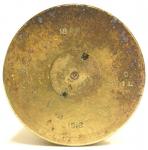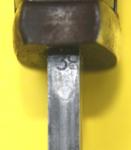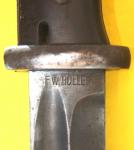-
Posts
13,225 -
Joined
-
Last visited
-
Days Won
22
Content Type
Profiles
Forums
Blogs
Gallery
Events
Store
Everything posted by Mervyn Mitton
-
This is the end and the dagger handle http://gmic.co.uk/uploads/monthly_10_2012/post-6209-0-57151400-1349108142.jpgclick
-
-
I am told this is an Iraqi sword - one used by the desert tribes. These days it is more likely to be an AK47 - however, the workmanship and decoration is interesting. The blade is probably an old jeep spring - so many of the North African swords have their origins from this source. I found it interesting that there is a sword at one end and a dagger at the other. The leather is from a camel and the embossing on the leather - all hand done. http://gmic.co.uk/uploads/monthly_10_2012/post-6209-0-97922700-1349107883.jpgclick
-
I think you will find this an interesting item. The shell case is for an 18 pounder artillery field gun - the main artillery weapon of the time and very widely used. Unusually, it has an Australian slouch hat Rising Sun badge fixed to the brass. This immediately suggests an Australian memento. Not the Dardenelles - the Anzacs had been withdrawn at the end of 1915. However, they continued in the Mesopotamia campaigns into 1918. Many Aust. units also served in France. The origins of this shell are therefore, rather abstract. I think we can safely say that it has an Australian connection - although we will probably never know if it was for a serving survivor - or, perhaps taken home by a visiting relative in the years following the War. I think we must hope it was the former. The details on the base are clearly shown - as is the date 1916. The wear to the brass on the back could indicate that it lay in a trench - or, on a beach for a number of years. ........................................................................http://gmic.co.uk/uploads/monthly_10_2012/post-6209-0-01015200-1349106187.jpgclick..................................................
-

K98 Bayonet
Mervyn Mitton replied to Mervyn Mitton's topic in Germany: Third Reich: Uniforms, Headwear, Insignia & Equipment
-

K98 Bayonet
Mervyn Mitton replied to Mervyn Mitton's topic in Germany: Third Reich: Uniforms, Headwear, Insignia & Equipment
-

K98 Bayonet
Mervyn Mitton replied to Mervyn Mitton's topic in Germany: Third Reich: Uniforms, Headwear, Insignia & Equipment
-

K98 Bayonet
Mervyn Mitton replied to Mervyn Mitton's topic in Germany: Third Reich: Uniforms, Headwear, Insignia & Equipment
Thanks for your interest Chris. A few detail photos herewith. Mervyn http://gmic.co.uk/uploads/monthly_09_2012/post-6209-0-45490500-1349013749.jpgclick -

Seeking Help
Mervyn Mitton replied to fabwab's topic in Great Britain: Research, Documentation & History
Fabwab - welcome to GMIC. I think Peter has given a good explanation to you and I agree with his interpretation for a mistake on the date. Quite common with inscriptions. Mervyn -

The Legion of Frontiersmen
Mervyn Mitton replied to leigh kitchen's topic in Great Britain: Research, Documentation & History
That is a 'Feather in your Cap' to be part of the City of London help squad. Well done, When the booklet is available let us know where our Members could apply for one - you could well gain some dedicated help. Mervyn -
I agree with Greg - after so many years it would be difficult to establish new evidence to allow the award of a VC. Doing so could also raise the expectations of families, who really have only hearsay to back their claims. Incidentally, the first two postumous awards for the VC were to Lieutenants Coghill and Melville - they saved the Colours at the Battle of Isandlawana in 1879. Mervyn
-

British Troops bravery honours
Mervyn Mitton replied to JPL's topic in Great Britain: Orders, Gallantry, Campaign Medals
When you read this you realise the great bravery shown by so many of the troops. Thanks Jean-Paul for posting this. Mervyn -

K98 Bayonet
Mervyn Mitton replied to Mervyn Mitton's topic in Germany: Third Reich: Uniforms, Headwear, Insignia & Equipment
I originally identified it as the 1914 pattern - changed from the South American version . http://gmic.co.uk/uploads/monthly_09_2012/post-6209-0-92988300-1348771521.jpgclick -

Part 13 - POLICE FORCES OF THE WORLD
Mervyn Mitton replied to Mervyn Mitton's topic in Police Forces of the World
Jeff - thankyou for this information. The cap is nicely made and ther badge is a sign that the Town respects it's Police. Best wishes. Mervyn -

Guess the Force!
Mervyn Mitton replied to Polsa999's topic in Great Britain: Mervyn Mitton's British & Colonial Police Forces
Steve - sad that you have still been unwell. Don't worry about comps. etc. - your health comes first. Members like these old photos - so just a few when you feel able. (drop me an IM when you can) Mervyn -
abu-klea. Welcome to GMIC and I hope this will be the first of many posts. Staff Officers have worn just the Royal Arms for many years - showing that they are not Regimentally attached at that time. I think this could well be the case here - however, as always with uniforms and insignia, there can be varying explanations. We shall have to see what other Members think. Are there any names or markings inside ? Mervyn
-

K98 Bayonet
Mervyn Mitton replied to Mervyn Mitton's topic in Germany: Third Reich: Uniforms, Headwear, Insignia & Equipment
-

Old (and new) deep sea diver toys.
Mervyn Mitton replied to Belaruski's topic in Non Military Collectibles & Antiques
I think members would find some illustrations of a few of your items to be interesting ? We often see old diving knives, however, none at present. Mervyn

















